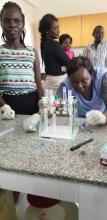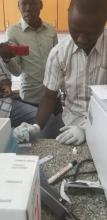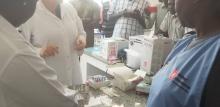WHO steps up efforts to accelerates the elimination of human African trypanosomiasis (HAT) in South Sudan
Human African trypanosomiasis, or sleeping sickness, threatens millions of people in many countries across sub-Saharan Africa.
South Sudan is one of the countries most affected by sleeping sickness. In 2018, a total of 5 469 people were screened (5 330 actively and 139 passively) for sleeping sickness of which 13 patients were treated.
In an effort towards the elimination of the human African trypanosomiasis (HAT), WHO trained health experts on the use of different diagnostic tools and case management.
The objective of the training was to empower national personnel from seven hospitals located in key HAT endemic areas of South Sudan in charge of HAT control to optimize diagnosis and treatment, strengthen surveillance and plan effective control and elimination activities and reinforce communications and supply chain for an uninterrupted functioning of the sites.
The participants also provided with laboratory reagents and blood sampling materials for kick-starting new diagnostic capacities in the seven sites.
HAT is a parasitic disease that is fatal if left untreated. The disease is transmitted by the tsetse fly where it mainly affects impoverished rural communities.
“Sleeping sickness is endemic in South Sudan”, says Mr Evans Liyosi, WHO Representative a.i. for South Sudan. HAT elimination requires combined efforts of WHO, National Sleeping Sickness Control Programmes, and other partners to strengthen control activities and improve the surveillance of the disease.
Since 2006, control interventions including access to diagnosis and treatment have been considerably diminished due to insecurity, impassable roads as well as the withdrawal of NGOs providing HAT diagnosis and treatment activities. Epidemiological history in HAT endemic areas shows that such a situation could lead to a new epidemic situation.
In spite of the insecurity, WHO is taking every opportunity to ensure that people are reached with health care services.
The task is huge and requires continuing coordination and long-term commitment of donors and partners, to implement most of the planned interventions, said Dr Pinyi Nyimol Mawien Apur, Director General Preventive Health Services.
WHO has laid out a roadmap to eliminate the disease as a public health problem by 2020. Maximizing efficiency in order to achieve elimination is currently underway.





